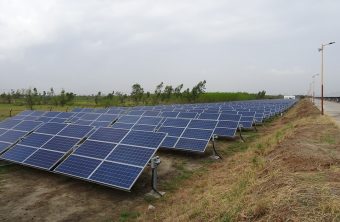India says it intends to launch a tender for 100 gigawatts of solar power, 10 times the size of the current largest solar tender in the world – another Indian project scheduled to open for bids next month.

But analysts have said the country has neither the infrastructure nor the energy demand to warrant installing so much solar capacity in one go, saying the announcement reflects the scale of India’s ambition to become a renewable energy leader.
It is one of several green power promises made by Delhi this month on the back of continually falling renewables prices, with implications for coal projects including the proposed Adani Group mine in Queensland, Australia.
The Indian power minister RK Singh flagged the 100GW tender at an event in Delhi last week. While discussing a world record 10GW solar tender set to launch in July, Singh reportedly told the audience: “Now [we] will bring out a bid of one lakh megawatts which would also include solar manufacturing and storage.”
One lakh refers to 100,000 in the south Asian numbering system, equivalent to 100GW.
His office confirmed the plan to the Guardian but declined to provide further details other than that the tender would be launched “in the near future”.
The unscheduled announcement surprised some energy policy specialists who said it was unrealistic and unnecessary.
“There are many, many operational constraints to the plan in terms of land availability, transmission connections, who’s going to buy and pay for those [transmission] towers, and so forth,” said Vinay Rustagi, the managing director of Bridge to India, a renewable energy consulting firm.
“I don’t think a 100GW tender makes a lot of sense,” said Tim Buckley, a director at the pro-renewables Institute for Energy Economics and Financial Analysis, but adding he thought the plan was a “brilliant statement of intent”.
Delhi announced this month it was raising its target for the amount of renewable energy capacity it plans to install by 2022 to more than 227GW. The previous target, already considered ambitious, was 175GW.
About 70GW have been installed so far and another 40 are under construction or being put out to tender, according to government data from June.
Buckley said on current trends India was unlikely to reach the 227GW target, but said it was setting an aspirational goal to attract investment and develop the local industry. “The idea is, aim for the moon and you’ll hit the top of the tree,” he said.
There are constraints on how fast additional capacity can be added, not least the fact that India simply does not need much more power.
“India is not a hugely starved country in terms of power supply,” said Rustagi. “The growth in demand on the whole is pretty stable at 4% to 5%, and there is already enough capacity being added to the system to cater to this incremental demand.”
More than 200 million Indians still live without regular access to electricity. But Indians are among the lowest per capita users of electricity in the world, especially those being newly connected to the grid.
“These are all relatively poor rural households with very little demand for power,” said Rustagi. “Even if all the 250 million-odd people without electricity got power in the next year, our analysis says power demand would grow by about an additional 1%.”
He chalked up the government’s big energy promises to national polls looming next year. “The election is coming up in 2019 and they are facing various economic and industrial challenges,” he said. “I think it’s more a part of putting a very positive spin on messages.”
At the beginning of the decade, India had planned to power its growth almost entirely using thermal coal, with about 600GW of coal power plant projects in the pipeline in 2010. Its plan spelled disaster for global efforts to keep warming below the two-degree target set by the Paris climate accords.
But as the price of renewables has crashed, and the impact of fossil fuels on Indian air and water has become clearer, the country has sought to reinvent itself as a green energy leader.
“We have missed the first and second industrial revolutions,” Singh said at an event in Delhi on Friday. “We caught up with the digital revolution, but we need to lead this revolution towards clean energy and renewable energy.”
India has shelved or cancelled nearly 550 thermal coal projects in the past seven years, Buckley said. More projects are likely to be cancelled as the price of renewables continues to fall: a report released by Bloomberg New Energy Finance last week estimated the cost of solar and wind in India was now 50% cheaper than coal.
Singh said on Friday coal would remain a part of India’s energy mix because it was “a backbone” to the intermittent power provided by renewables.
But researchers say the proportion of energy the country derives from coal will keep falling – and that diminishing demand can easily be met by Indian mines, raising questions about the need for new projects such as the proposed Carmichael mine in the Galilee Basin of Queensland, Australia.
“The incremental demand for thermal power in India is very little,” Rustagi said. “I don’t see how it makes sense to undertake a huge international project like [the Carmichael mine] … when we have enough domestic coal available.”
Source: Guardian



